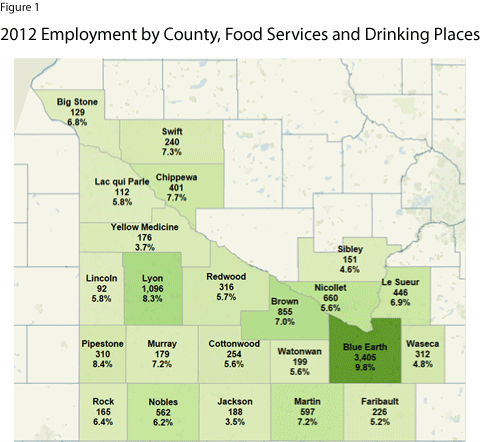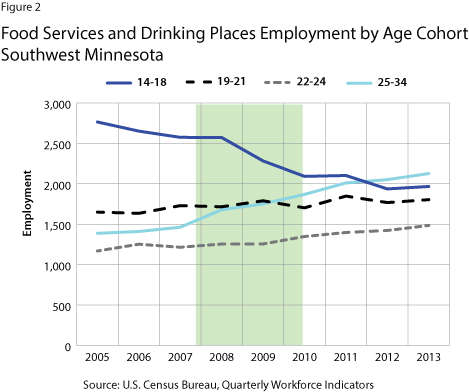by Mark Schultz and Luke Greiner
September 2014
In the 23-county Southwest Minnesota planning area the food services and drinking places industry provides almost 11,000 jobs. Over 80 percent of industry employment in the region is in the restaurant sector, including 42 percent in limited-service restaurants and 40 percent in full-service restaurants. In comparison, full-service and limited-service restaurants also make up the bulk of employment in this industry statewide, though there is a higher percentage (49 percent) in full-service restaurants and a lower percentage in limited service restaurants (38 percent) in the state.
While full-service and limited-service restaurants account for the majority of the total employment in the industry, six other sectors within the industry provide other options. The remaining sectors include drinking places (alcoholic beverages), food service contractors, cafeterias, grill buffets and buffets, snack and non-alcoholic beverage bars, caterers, and mobile food services.
Table 1 shows the average number of establishments, employment, and weekly wages for each sector in the industry. Average weekly wages are obviously low in the industry, but that is partly from the large number of part-time and seasonal jobs. According to DEED's Job Vacancy Survey, 72 percent of jobs in food preparation and serving-related occupations are part-time and another 7 percent are temporary or seasonal, on top of median wage offers of just $7.61 an hour.
| Industry Employment Statistics for the Food Services and Drinking Establishments Sector in Southwest Minnesota, 2013 | ||||
|---|---|---|---|---|
| Sector | Number of Establishments, 2013 | Number of Jobs, 2013 | Total Payroll, 2013 | Average Weekly Wages |
| Food Services and Drinking Places | 735 | 10,890 | $115,036,721 | $203 |
| Special Food Services | 35 | 365 | $4,242,855 | $223 |
| Food Service Contractors | 17 | 257 | $3,266,205 | $245 |
| Caterers | 14* | 104* | $431,140* | $160* |
| Mobile Food Services | 5* | 10* | $21,301* | $83* |
| Drinking Places (Alcoholic Beverages) | 138* | 1,036* | $7,348,810* | $181* |
| Restaurants | 562 | 9,485 | $100,973,986 | $204 |
| Full-Service Restaurants | 272 | 4,411 | $49,075,722 | $214 |
| Limited-Service Restaurants | 253 | 4,585 | $45,686,096 | $191 |
| Cafeterias, Grill Buffets and Buffets | 10 | 255 | $3,799,660 | $288 |
| Snack and Non-Alcoholic Beverage Bars | 30 | 238 | $2,412,508 | $196 |
| *Because these are seasonal industries, data are not available for all 4 quarters. Therefore data in this chart averages the quarters available.
Source: DEED's Quarterly Census of Employment and Wages (QCEW) program |
||||
Food services and drinking places provide roughly 7.6 percent of all jobs across Southwest Minnesota, although this concentration varies by county. Blue Earth County, home to Mankato, the largest city in the region, has the largest amount of industry employment with 3,405 jobs. Add in Nicollet County's 660 jobs, and more than one-third (36.7%) of the region's food services and drinking places employment are located in the Mankato-North Mankato Metropolitan Statistical Area.
There were also larger numbers of jobs in the region's micropolitan areas, including Marshall and Lyon County (1,096 jobs), New Ulm and Brown County (855 jobs), Fairmont and Martin County (597 jobs), and Worthington and Nobles County (562 jobs). Combined, these six counties offer nearly two-thirds (64.8%) of the region's food services and drinking places jobs.
In the smaller counties there were large variations in the number and concentration of food services and drinking places employment. For example, Pipestone County ranks 15th of the 23 Southwestern counties in terms of total employment and has the fifth smallest population, but had the second highest percentage of employment in the food services and drinking places sector. In contrast, Waseca County had over 20 percent more total jobs than Pipestone County, but about the same number of jobs in food services and drinking places (Figure 1).

Source: U.S. Census Bureau County Business Patterns, 2012, censtats.census.gov/cgi-bin/cbpnaic/cbpsect.pl
The workers who prepare, cook, and serve the dishes and cocktails for customers do it for relatively low wages, but still with a smile. While some occupations in the food services industry receive additional wages in the form of cash tips, many do not. Overall, the median hourly wage for all food serving and preparing occupations in Southwest Minnesota is $9.37. This is about 60 percent of the median hourly wage for all occupations in the region (Table 2).
| Employment and Wages of Food Serving and Preparing Occupations in Southwest Minnesota | ||||
|---|---|---|---|---|
| Occupational Title | Southwest MN Employment | Hourly Median Wage | Percent of MN Median | |
| Southwest | Minnesota | |||
| Total, All Occupations | 172,090 | $15.03 | $18.15 | 82.8% |
| Chefs and Head Cooks | 30 | $15.78 | $22.01 | 71.7% |
| First-Line Supervisors of Food Preparation Workers | 790 | $12.49 | $14.06 | 88.8% |
| Cooks, Fast Food | 320 | $8.65 | ND | ND |
| Cooks, Institution and Cafeteria | 670 | $11.81 | $12.84 | 92.0% |
| Cooks, Restaurant | 180 | $9.22 | $10.84 | 85.1% |
| Cooks, Short Order | 100 | $9.10 | $9.16 | 99.3% |
| Cooks, All Other | 60 | $11.99 | $11.18 | 107.2% |
| Food Preparation Workers | 700 | $9.64 | $10.59 | 91.0% |
| Bartenders | 810 | $8.65 | $8.80 | 98.3% |
| Combined Food Preparation and Serving Workers | 4,170 | $8.69 | $8.71 | 99.8% |
| Counter Attendants, Cafeteria, Food Concession | 410 | $8.74 | $8.78 | 99.5% |
| Waiters and Waitresses | 620 | $8.55 | $8.68 | 98.5% |
| Food Servers, Non-restaurant | 520 | $9.51 | $10.31 | 92.2% |
| Dining Room and Cafeteria Attendants | 60 | $8.65 | $8.84 | 97.9% |
| Dishwashers | 220 | $8.59 | $8.88 | 96.7% |
| Hosts and Hostesses, Restaurant, Lounge, and Coffee | 40 | $8.75 | $8.65 | 101.2% |
| All Other Food Preparation and Serving Related Workers | 10 | $9.34 | $10.23 | 91.3% |
| Source: DEED Occupational Employment Statistics | ||||
Although they typically operate behind the scenes in the kitchen, the most common occupation in food services is combined food preparation and serving workers, accounting for 43 percent of employment in the field. They do both most commonly at fast food establishments. Other common occupations include first-line supervisors of food preparation workers; all types of cooks, ranging from fast food and short order to restaurant, institution, and cafeteria; and waiters, waitresses, and other food servers.
Despite being relatively low-paying, all of the occupations listed in Table 2 have higher median wages than the new $8.00 per hour minimum wage that went into effect in August, 2014 for large employers. However, based on data from DEED's Occupational Employment Statistics (OES) program, the wage hike will likely affect some workers in many of the occupations in the industry.
Workers in Greater Minnesota, especially in higher-earning occupational groups like management, computer and mathematical, and architecture and engineering, earn less than their counterparts in the metro area. However, workers in the most common food service occupations enjoy a much smaller pay gap than other workers in Southwest Minnesota. With the exception of chefs and head cooks, every major food service occupation pays much closer to the state's median wage than the total for all occupations.
For all occupations in Southwest Minnesota, workers make 83 percent of the median wage in the state. Many of the food serving and preparing occupations, on the other hand, pay 95 percent or more of the Minnesota median. These include short order cooks, all other cooks, bartenders, combined food and preparation serving workers, counter attendants, waiters and waitresses, dining room and cafeteria attendants, bartenders, and host and hostesses. Host and hostesses and all other cooks in Southwest Minnesota actually make more than the state's median for the occupation, at 101 percent and 107 percent of the state's median hourly wage, respectively.
Many of these occupations provide great entry-level jobs for the youngest workers in the labor force, becoming a place where they can learn job responsibilities and create a foundation for future work experiences. Data show that food services and drinking places can be a good start for many workers to learn the ins and outs of being a professional, with the flexibility and limited hours that they also provide.
However, a recent decrease in the number of younger workers aged 14 to 18 is transforming the workforce of the food services and drinking places industry. With declining census numbers for the age cohort, the youngest age group is being replaced by their older counterparts in the workforce (Figure 2).

It is important to note that the loss in 14- to 18-year-olds was not limited to Southwest Minnesota or to the food services and drinking places industry, but it is vital to both. The loss of these workers in the region was much more dramatic than in the state of Minnesota. Since 2005 the number of 14- to 18-year-olds working in food services and drinking places decreased over 40 percent in Southwest Minnesota, while the state has 19 percent fewer younger workers in the industry.
This loss has led to an increase in the 25- to 34-year-old age cohort, which has seen their employment in this industry jump by 53 percent in Southwest Minnesota, almost twice as fast as the state's 27 percent increase. Changing demographics are certainly playing a part in this age shift, but other reasons including a surplus of workers during the recession and increasing standards for applicants could also be affecting the industry in the region.
As the labor market continues to tighten, and if the 25- to 34-year-olds begin to be offered other types of employment, it is possible that the youngest group of workers will again be tapped to fill the needed labor demand of the food services and drinking places industry.
Food services and drinking places are projected to grow a modest 3.3 percent from 2010 to 2020 in Southwest Minnesota, adding about 350 net new jobs. While that is not as fast as the state or the total of all industries in the region, it shows there will be demand for these workers in the future. The good news is that if the food services and drinking places industry maintains its projected employment growth, there will continue to be a wide variety of dining options in Southwest Minnesota.